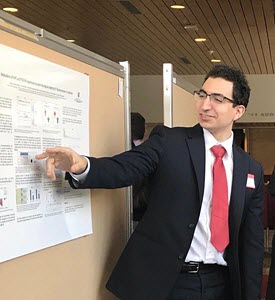NYMC Medical Student Continues Research into New Treatments for Deadly Form of Brain Cancer
Student developed research interests into a new standard of care for deadly illness prior to entering medical school

High-grade gliomas, historically called glioblastoma multiforme or GBMs, are the most common and deadly of the primary brain cancers, with an average survival rate of 12 to 18 months and just a five percent, five-year survival rate even with current aggressive therapy.
Throughout his years at NYMC, Eric Feldstein, SOM Class of 2021, has continued his involvement in research he began before medical school to discover a new standard of care for this deadly illness, in conjunction with his mentor, Adam Sonabend, M.D., currently assistant professor of neurological surgery at the Robert Lurie Comprehensive Cancer Center at Northwestern University.
“A diagnosis of GBM is devastating,” says Mr. Feldstein. “This is a disease that strikes generally unexpectedly. A person who has had no family history and is otherwise healthy starts getting worsening headaches over the course of some weeks and may develop seizures or focal neurologic deficits. After imaging and then a biopsy, what was once thought to be just a headache has been revealed as their future cause of death.”
Historically, brain cancer was diagnosed, identified and set up for treatment through histology, however, in 2016, the World Health Organization came out with a classification of gliomas based on genotyping, a harbinger of the trajectory for glioma research. “Genotyping has shown that the title high-grade glioma masks the fact that the disease is heterogeneous,” says Mr. Feldstein. “One person’s cancer is not like another, and treatment potentially beneficial for one is not beneficial for someone else. Instead of finding the right cure for gliomas, the name of the game could be finding the right glioma for the cure.”
For the research, they focused on the use of topoisomerase 2 (TOP2) inhibitors for the treatment of high-grade glioma, specifically examining where TOP2 binds on the native genome as well as where it is activated. “Based on previous findings that some strains of human glioma could be treated effectively with topoisomerase inhibitors and poisons, and knowing that a TOP2 poison such as etoposide was already used in the chemotherapeutic world to treat a subset of human glioma, allowed us to explore genome regulation in these cancers.”
Mr. Feldstein’s specific responsibilities were designing and conducting Chromatin Immunoprecipitation Sequencing (ChIP-seq) experiments, which involved collecting the population of DNA bound to topoisomerase and creating a visual map of where in the genome this protein binds across various human glioma models.
Their most recent work, Ribosomal protein S11 influences glioma response to TOP2 poisons, which was published in June, explored the population of genes that helped confer susceptibility to etoposide.
“The significance of this research is two-fold,” says Mr. Feldstein “First, we have new research targets to study in our quest to better understand the regulation of human gliomas. Second, we have a proof of concept that we can take a human glioma sample, test it for the presence or absence of a specific protein, and then know if a certain treatment option will be worth considering. In many ways this is now high-grade glioma orthodoxy, the search of genetic markers to drive individualized therapy.”
“Like many neurological disorders, the symptoms one has from glioma cancer hits at things that are fundamental to a person’s identity. Either by progression of disease, or by our best attempts at curing it, the patient can lose the use of their limbs, their ability to speak, lose their memory, the function of their senses or more. These are losses that happen to fundamentally healthy human beings who, along with their loved ones, are blindsided by the diagnosis. As future and current healthcare providers, our goal is to alleviate suffering and cure human disease. It’s a great gift to be invited into people’s lives at their most vulnerable, trusted to help in any way we can and to hold that trust with no small degree of humility. No matter if one works in the wards, the OR, the classroom or the laboratory, they are a trusted caretaker of countless tales of humans and the diseases they fight.”
